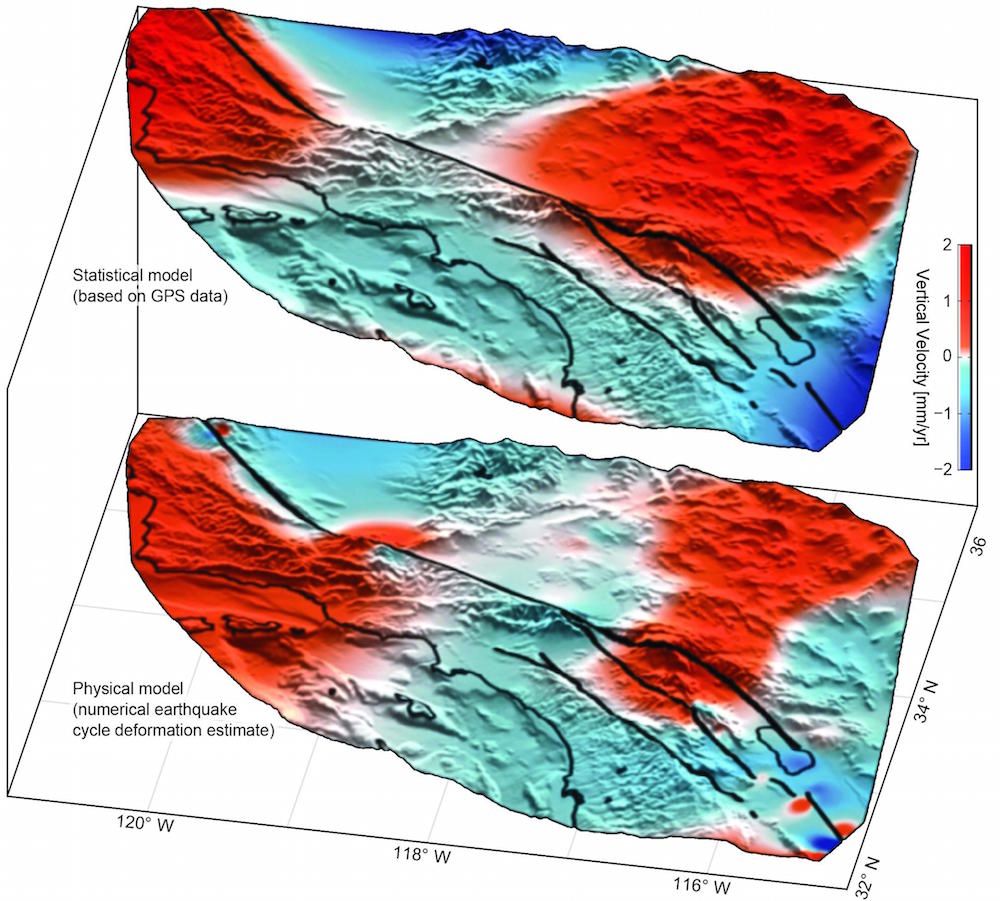
For the first time, scientists have revealed the vertical motion that has been hiding in plain sight along the San Andreas Fault.
Four huge lobes of the Earth on either side of the San Andreas Fault are sinking, while others are rising, a new analysis of GPS data reveals. The simple motion makes it look as if the ground under the fault is doing the wave in slow motion.
"While the San Andreas GPS data has been publicly available for more than a decade, the vertical component of the measurements had largely been ignored in tectonic investigations because of difficulties in interpreting the noisy data," study lead author Samuel Howell, a doctoral candidate in ocean and earth science and technology at the University of Hawai'i at Mānoa, said in a statement.
Now, using a new technique, researchers were able to tease out the vertical motion, which "curiously straddled the San Andreas Fault," Howell added. [Photo Journal: The Gorgeous San Andreas Fault]
For more than a decade, tiny GPS arrays have dotted the land along the San Andreas Fault, the region where the North American and the Pacific plates collide. The 800-mile-long (1,287 kilometers) fault system, which creates a threaded network of many smaller faults, snakes through California from the Mendocino Coast in the north to the Salton Sea in the south.
In the past, researchers have mainly relied upon the GPS sensor data to determine the horizontal motion of the fault. But the vertical motion of the fault can be affected not only by tectonic motion of the plates, but also by everything from rainfall to the levels of groundwater (which have dropped dramatically as a result of California's drought) to local surface geology. Teasing apart the tectonic motion from these other, more transient factors was a challenging task, the researchers said.
"You can picture an old radio where you want to listen to your favorite show (vertical motion that the fault causes). You would have to turn the knob through other stations (natural and human-caused ground movements) and through a lot of static," Howell told Live Science in an email. "We wanted to dial-in to the part of the vertical signal that was due to the fault."
Get the world’s most fascinating discoveries delivered straight to your inbox.
So Howell's team used a statistical technique to extract smooth trends in ground motion from the noisy data.
They found that there were four large hunks of ground about 125 miles (201 km) wide that were uplifting or subsiding on either side of the fault. What's more, the findings matched theoretical models for how the earth around the fault was moving in response to powerful earthquakes.
"We were surprised and thrilled when this statistical method produced a coherent velocity field similar to the one predicted by our physical earthquake-cycle models," study co-author Bridget Smith-Konter, a geologist at the University of Hawai'i at Mānoa, said in the statement.
As for the cause of this wave-like movement, "these vertical motions didn't just now start happening, but have been building up since the last major earthquake, and will begin to go away after the next one," Howell said. "We knew that the ground had to be moving up and down somehow, but this provides a measurement of that motion."
The creeping vertical motion is tiny, just a few millimeters, or two penny-widths a year, and doesn't add much to the seismic risk in the region, Howell said.
"The major risks come from the horizontal motions near the fault. The vertical motion comes from the fault being locked, [or] unable to move, between earthquakes," Howell said.
But the new understanding does create a more detailed understanding of the fault, which could in turn help with estimating the risk of future ruptures along the fault, the researchers reported June 20 in the journal Nature Geoscience.
Original article on Live Science.

Tia is the editor-in-chief (premium) and was formerly managing editor and senior writer for Live Science. Her work has appeared in Scientific American, Wired.com, Science News and other outlets. She holds a master's degree in bioengineering from the University of Washington, a graduate certificate in science writing from UC Santa Cruz and a bachelor's degree in mechanical engineering from the University of Texas at Austin. Tia was part of a team at the Milwaukee Journal Sentinel that published the Empty Cradles series on preterm births, which won multiple awards, including the 2012 Casey Medal for Meritorious Journalism.
